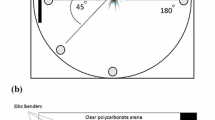Summary
-
1.
Both amplitude and frequency contents of male courtship vibrations of Cupiennius salei change with signal propagation through a bromeliad (Fig. 3). Temporal pattern and carrier frequency of the opisthosomal signal (Fig. 1a) remain largely unchanged, however, and therefore satisfy the requirements to carry species specific information. Pedipalpal signals cover a broad range of frequencies (Fig. 3a, c); both their dispersive transmission and the frequency-dependent attenuation by the plants may provide the female with information about her distance from the male.
-
2.
Parallel processing of different signal components already begins in the female's metatarsal lyriform vibration receptor. Opisthosomal signals: They mainly elicit responses from long distal slits; signal amplitude is of only minor influence (Fig. 7). Carrier frequency is represented by interspike frequencies of individual slits (Fig. 8b, d). Pedipalpal signals: They elicit responses from all slits (Figs. 6, 7a). Responses of individual slits differ and can be assigned to specific frequency components contained in a pedipalpal signal (Figs. 6, 8a, 9b).
-
3.
The repetition of opisthosomal signals within the male courtship vibration improves the signal to noise ratio in the female's receptor response (Fig. 10).
-
4.
For unknown reasons the intensity of the receptor response follows changes in acceleration amplitude in the case of heterospecific but not in the case of conspecific courtship vibrations (Fig. 11).
Similar content being viewed by others
Abbreviations
- MO :
-
metatarsal lyriform organ
- ISFH :
-
interspike frequency histogram
- FFT :
-
Fast Fourier transform
- PSTH :
-
peristimulus time histogram
References
Barth FG (1967) Ein einzelnes Spaltsinnesorgan auf dem Spinnentarsus: seine Erregung in Abhängigkeit von den Parametern des Luftschallreizes. Z Vergl Physiol 55:407–449
Barth FG (1972) Die Physiologie der Spaltsinnesorgane. II. Funktionelle Morphologie eines Mechanoreceptors. J Comp Physiol 81:159–186
Barth FG (1982) Spiders and vibratory signals: sensory reception and behavioral significance. In: Witt PN, Rovner JS (eds) Spider communication: mechanisms and ecological significance. Princeton Univ Press, Princeton NJ, pp 67–122
Barth FG (1985) Neuroethology of the spider vibration sense. In: Barth FG (ed) Neurobiology of arachnids. Springer, Berlin Heidelberg New York, pp 203–229
Barth FG (1986) Vibrationssinn und vibratorische Umwelt von Spinnen. Naturwissenschaften 73:519–530
Barth FG (1992) Sensory guidance in spider precopulatory behaviour. In: Barnes WJP (ed) Sensory guidance in arthropod behaviour. Manchester University Press, Manchester (in press)
Barth FG, Bohnenberger J (1978) Lyriform slit sense organ: thresholds and stimulus amplitude ranges in a multi-unit mechanoreceptor. J Comp Physiol 125:37–43
Barth FG, Geethabali (1982) Spider vibration receptors. Threshold curves of individual slits in the metatarsal lyriform organ. J Comp Physiol 148:175–185
Barth FG, Libera W (1970) Ein Atlas der Spaltsinnesorgane von Cupiennius salei Keys. Chelicerata (Araneae). Z Morphol Tiere 68:343–368
Barth FG, Schmitt A (1991) Species recognition and species isolation in wandering spiders (Cupiennius spp., Ctenidae). Behav Ecol Sociobiol 29:333–339
Barth FG, Bleckmann H, Bohnenberger J, Seyfarth EA (1988) Spiders of the genus Cupiennius Simon 1891 (Araneae, Ctenidae). II. On the vibratory environment of a wandering spider. Oecologia 77:194–201
Baurecht D, Deutsch WA, Noll A, Barth FG (1989) Digital signal processing system: recording, analysis and replay in bioacoustical experiments. In: Elsner N, Singer W (eds) Dynamics and plasticity in neuronal systems. Thieme, Stuttgart New York, p 141
Bleckmann H (1991) Orientation in the aquatic environment with aid of hydrodynamic stimuli. Verh Dtsch Zool Ges 84:105–124
Bleckmann H, Barth FG (1984) Sensory ecology of a semi-aquatic spider (Dolomedes triton). II. The release of predatory behavior by water surface waves. Behav Ecol Sociobiol 14:303–312
Bohnenberger J (1981) Matched transfer characteristics of single units in a compound slit sense organ. J Comp Physiol 142:391–402
Hergenröder R, Barth FG (1983) The release of attack and escape behavior by vibratory stimuli in a wandering spider (Cupiennius salei Keys.). J Comp Physiol 152:347–358
Keuper A, Kühne R (1983) The acoustic behaviour of the bushcricket Tettigonia cantans. II. Transmission of airborne-sound and vibration signals in the biotope. Behavioural Processes 8:125–145
Lachmuth U, Grasshoff M, Barth FG (1984) Taxonomische Revision der Gattung Cupiennius Simon 1891 (Arachnida: Araneae). Senckenbergiana Biol 65: 329–372
Liesenfeld (1961) Über Leistung und Sitz des Erschütterungssinnes von Netzspinnen. Biol Zentralbl 80:465–475
Markl H (1969) Verständigung durch Vibrationssignale bei Arthropoden. Naturwissenschaften 56:499–505
Michelsen A, Fink F, Gogala M, Traue D (1982) Plants as transmission channels for insect vibrational songs. Behav Ecol Sociobiol 11:269–281
Robinson MH (1982) Courtship and mating behavior in spiders. Annu Rev Entomol 27:1–20
Rovner JS, Barth FG (1981) Vibratory communication through living plants by a tropical wandering spider. Science 214:464–466
Schmitt A, Schuster M, Barth FG (1992) Male competition in a wandering spider (Cupiennius getazi, Ctenidae). Ethology (in press)
Schüch W, Barth FG (1985) Temporal patterns in the vibratory courtship signals of the wandering spider Cupiennius salei Keys. Behav Ecol Sociobiol 16:263–271
Schüch W, Barth FG (1990) Vibratory communication in a spider: female responses to synthetic male vibrations. J Comp Physiol A 166:817–826
Siegel S, Castellan NJ (1988) Nonparametric statistics for the behavioral sciences. McGraw-Hill, New York
Speck J, Barth FG (1982) Vibration sensitivity of pretarsal slit sensilla in the spider leg. J Comp Physiol 148:187–194
Speck-Hergenröder J, Barth FG (1987) Tuning of vibration sensitive neurons in the central nervous system of a wandering spider, Cupiennius salei Keys. J Comp Physiol A 160:467–475
Speck-Hergenröder J, Barth FG (1988) Vibration sensitive hairs on the spider leg. Experientia 44:13–14
Uetz GW, Stratton GE (1982) Acoustic communication and reproductive isolation in spiders. In: Witt PN, Rovner JS (eds) Spider communication: mechanisms and ecological significance. Princeton Univ Press, Princeton NJ, pp 123–159
Van de Römer A (1980) Eine vergleichende morphologische Untersuchung an dem für die Vibrationswahrnehmung wichtigen Distalbereich des Spinnenbeines. Diplomarbeit, Universität Frankfurt am Main, Federal Republic of Germany
Wirth E (1984) Die Bedeutung von Zeitund Amplitudenunterschieden für die Orientierung nach vibratorischen Signalen bei Spinnen. Diplomarbeit, Universität Frankfurt am Main, Federal Republic of Germany
Author information
Authors and Affiliations
Rights and permissions
About this article
Cite this article
Baurecht, D., Barth, F.G. Vibratory communication in spiders. J Comp Physiol A 171, 231–243 (1992). https://doi.org/10.1007/BF00188930
Accepted:
Issue Date:
DOI: https://doi.org/10.1007/BF00188930




